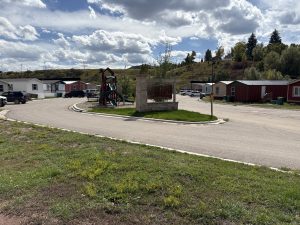New YVHA housing demand study underscores urgent need for affordable housing

Ben Saheb/Courtesy photo
A comprehensive new housing needs assessment commissioned by the Yampa Valley Housing Authority paints a stark picture of Routt County’s housing market: demand for affordable homes far outpaces supply, with the gap growing wider each year.
The 156-page study, conducted by Denver-based consulting firm Economic and Planning Systems, as well as Boulder-based market research firm RRC Associates, was presented to the Steamboat Springs City Council on Tuesday night, offering a detailed, up-to-date look at the region’s evolving housing crisis.
Patrick Phillips, YVHA board member and former CEO of the Urban Land Institute, opened the presentation by emphasizing the study’s breadth.
The report, said Phillips, “offers substantial additional data and insights into such questions as, why does this challenge exist? Why the mismatch between the supply of affordable housing options and the demand? What are the demographic and economic drivers at play? Who is primarily affected by this? What are their specific needs and wants? What are the main challenges in producing such housing?”
Unlike previous studies that relied mostly on secondary data, said Phillips, this assessment incorporated a statistically valid survey of nearly 2,700 area households, providing “a much more nuanced view of the issues and helped us to gauge more accurately the potential demand.”
Key findings
Economic and Planning Systems Principal Brian Duffany, who spearheaded the study, summarized the key takeaways.
“Routt County has reached a place where the housing market here is detached from local household incomes and wages. It no longer relates to the economy and the local household incomes of people,” said Duffany. “The region as a whole is shifting towards an older, wealthier, more part-time population.”
The study found housing gaps at nearly every income level and segment of the market, impacting everyone from restaurant workers to entry-level healthcare professionals, teachers and even new doctors.
“More than half of renters are cost-burdened and paying more than 30% of their income toward housing, and one in four are paying about half of their income or more in rent,” Duffany said.
The study estimates a need for approximately 3,200 additional housing units over the next decade, with about 2,100 needed to “catch up” to current demand and 1,100 to “keep up” with projected job growth.
In Steamboat, the median price in 2024 topped $1.3 million. Even traditionally more affordable areas like Stagecoach and Hayden have seen dramatic price increases.
“A two-person household earning 100% of (area median income), just under $100,000 a year, can afford a purchase price of about $360,000. So to buy the median priced home in Routt County, they would need another $780,000 or more to close that gap,” said Duffany. “Those are really large affordability gaps, on par with some of the most expensive communities in the state.”
Average rents surveyed in Routt County are about $2,100 per month, with many renters paying more than what homeowners pay for their mortgage.
Who is most affected?
The study’s survey revealed sharp divides between renters and owners.
While renters prioritize cost, proximity to jobs and pet-friendliness, said Duffany, owners value lifestyle factors like single-family homes, access to amenities and community character.
Duffany explained that young renters and newcomers face the highest housing insecurity, with 40% of renters unsure if they can remain in their current homes. Longtime owners, on the other hand, have some of the lowest housing costs and are less likely to perceive housing as the region’s most critical problem.
Hispanic and Latino households reported larger household sizes but lived in smaller, denser housing. They also had more jobs per household, longer commutes and higher levels of housing cost burden.
Furthermore, a significant portion of Routt County’s housing stock is not available to year-round residents.
Countywide, about 37% of homes are used as part-time or vacation properties, said Duffany. In Steamboat, that figure rises to 43%.
“This is important because the people that are buying homes in that market for that use are typically higher income, have higher net worth, and can out compete local buyers in housing. And people are rational economic actors, they’re going to sell to the highest bidder,” said Duffany. “Building attainable housing risks just building more attainable second homes.”
Methodology: “catch up” and “keep up”

The study’s demand estimate is split into two components: “catch up” and “keep up.”
The “catch up” component, accounting for about 2,100 units, addresses current deficits in housing supply and demand, including overcrowding, cost-burdened renters and owners and attracting local workers who commute from outside of Steamboat.
The “keep up” component, about 1,100 units, projects new housing needed to support expected job growth over the next decade.
“A big part of that catch-up need is alleviating the cost burden to people, and that’s roughly 1,600 units,” Duffany said. “No community that we’re aware of has the resources, has the land, the money, to address 100% of that need.
“Think about the catch up as really an order of magnitude assessment of how aligned or not aligned the housing market is with current conditions,” added Duffany.
“Would a good way to say it be that it’s not so much that it’s a shortage of units – it’s a shortage of specific units at specific rental rates?” asked Councilor Muntean.
“That’s a good way to say it,” replied Duffany.
During the public comment period, local resident Bill Pass described the study as “more credible than the prior study,” referencing last year’s study commissioned by YVHA ahead of the Brown Ranch annexation vote, but he raised questions about the impact of building new units.
“If you build all 1,600 of those units, you essentially depopulate 1,600 units. They’re already here, people already live in them,” said Pass. “That’s going to have a significant impact on the local market in terms of affordability.”
“I would posit that perhaps building half of that and seeing where you’re at afterwards, and seeing how that affects market dynamics might be a good approach for how to tackle this,” Pass added.
Interviews with local employers also revealed that housing is beginning to become a burden on the local economy.
“Every stakeholder we talked to told us about the difficulties in hiring and retaining employees because of housing costs and housing supply,” said Duffany. “I’d be concerned that housing is starting to become a constraint on the local economy.”
The study also underscores the difficulty of building affordable housing in Routt County.
“Land and construction costs just make it difficult to develop attainable housing without discounted or free land, and without a funding source for financing gap closure,” Duffany said. “The minimum entry point to building a single family home in Steamboat is buying a lot, and a lot starts at about $500,000, and there are not many of those.”
Policy implications and next steps
“The study is not a set of prescriptions,” Phillips clarified, “but we hope that it helps provide a strong empirical foundation for the ongoing community discussion about how we can all work together to create the strongest, most vibrant community we can.”
Councilor Joella West noted differences in housing demand projections between the latest housing needs survey and the one presented at Tuesday’s meeting.
Duffany said that this study, unlike the previous one, incorporated significant primary data, possibly leading to differences in findings, but said he would do a “side-by-side comparison” and return to council with additional information.
Council will review the full 156-page study in depth ahead of the next YVHA meeting, where the board will discuss its analysis of the study.
“The ability of the council, as well as the county, to make certain incentives and policies and tools available will modify this picture,” said Phillips at the close of the presentation. “But it clearly shows, there’s a very severe issue in the Valley with respect to housing, and there’s a sense of urgency around it. So we’re going to need a lot of arrows in that particular quiver, and the study convinces the community to support that.”

Support Local Journalism

Support Local Journalism
Readers around Steamboat and Routt County make the Steamboat Pilot & Today’s work possible. Your financial contribution supports our efforts to deliver quality, locally relevant journalism.
Now more than ever, your support is critical to help us keep our community informed about the evolving coronavirus pandemic and the impact it is having locally. Every contribution, however large or small, will make a difference.
Each donation will be used exclusively for the development and creation of increased news coverage.










